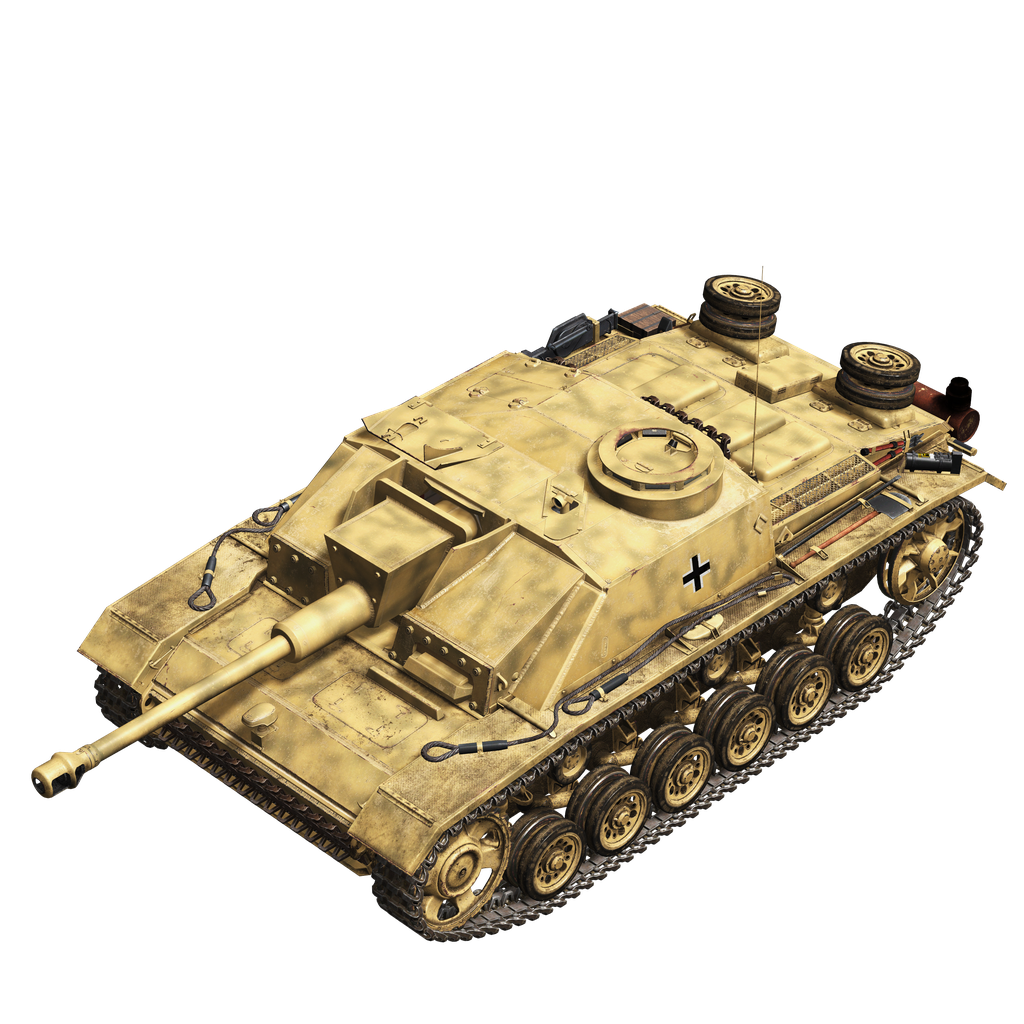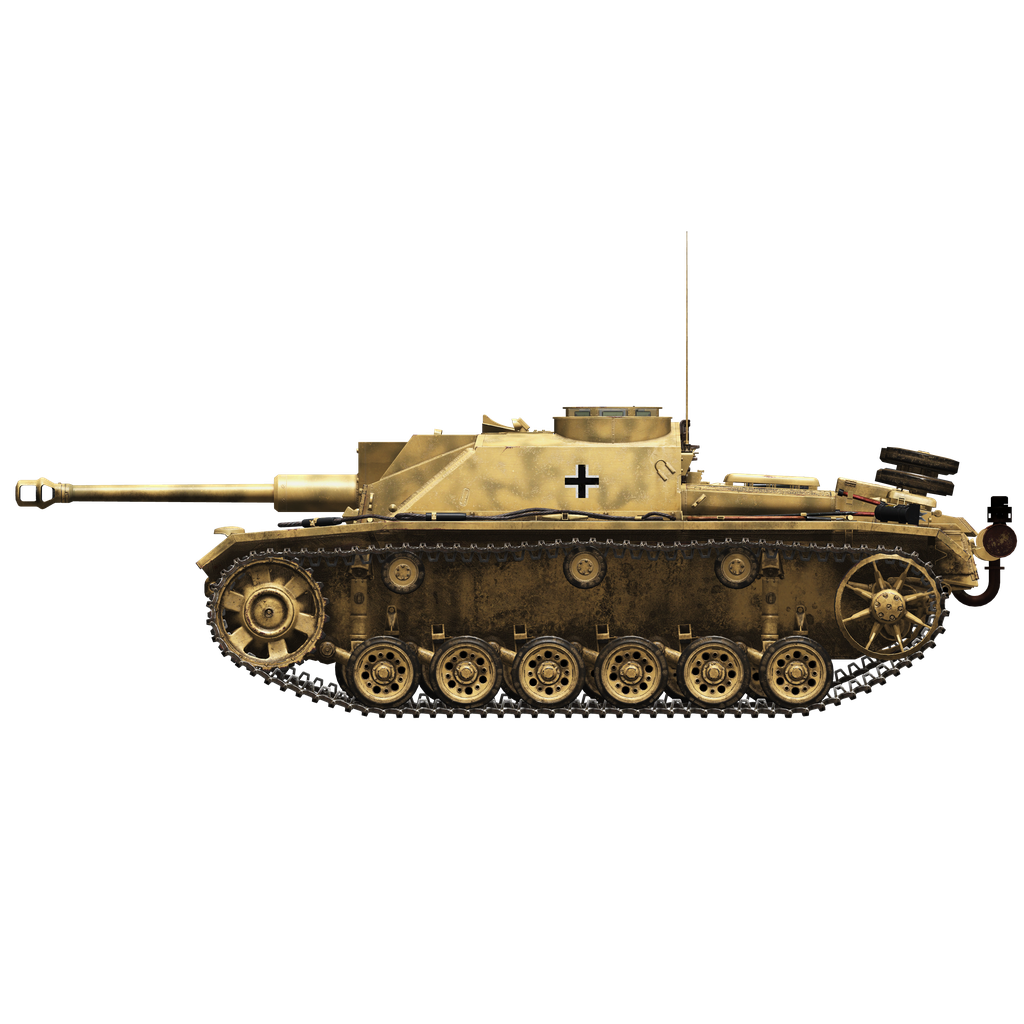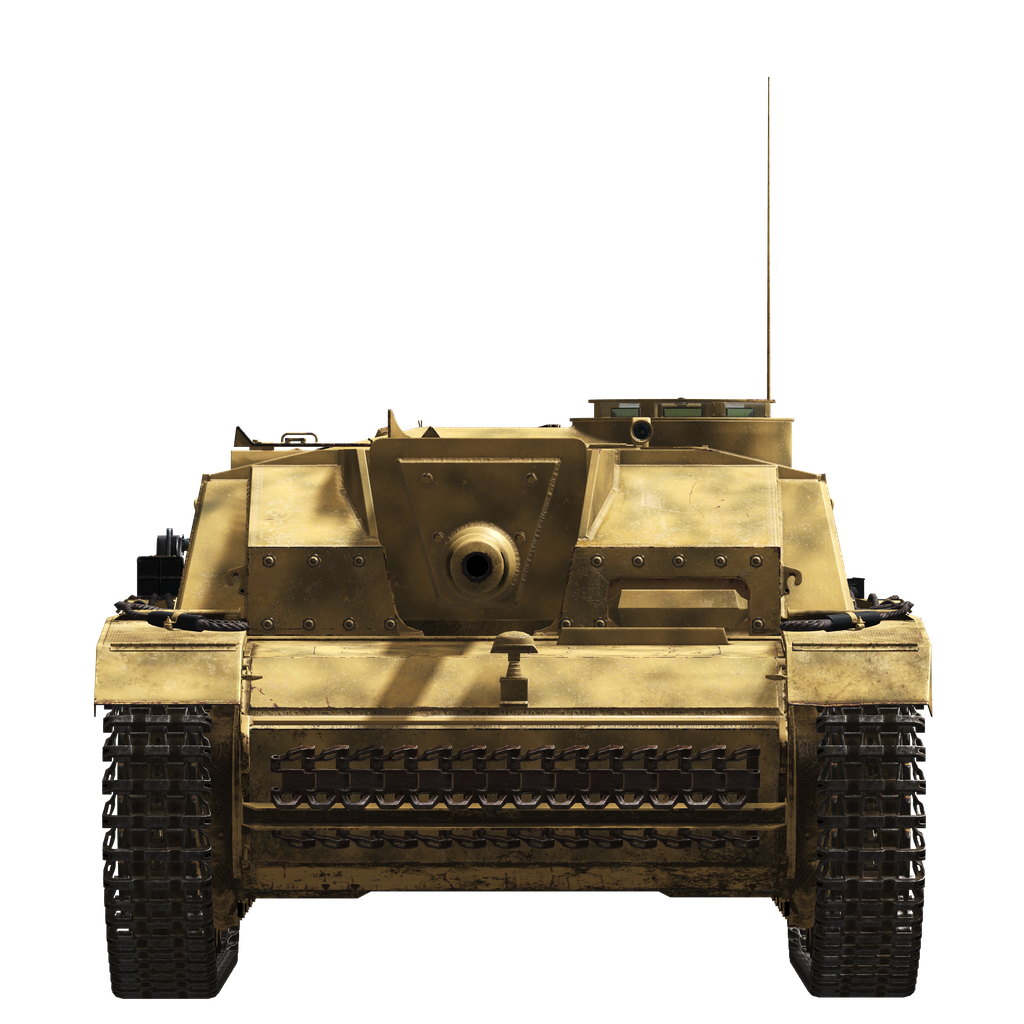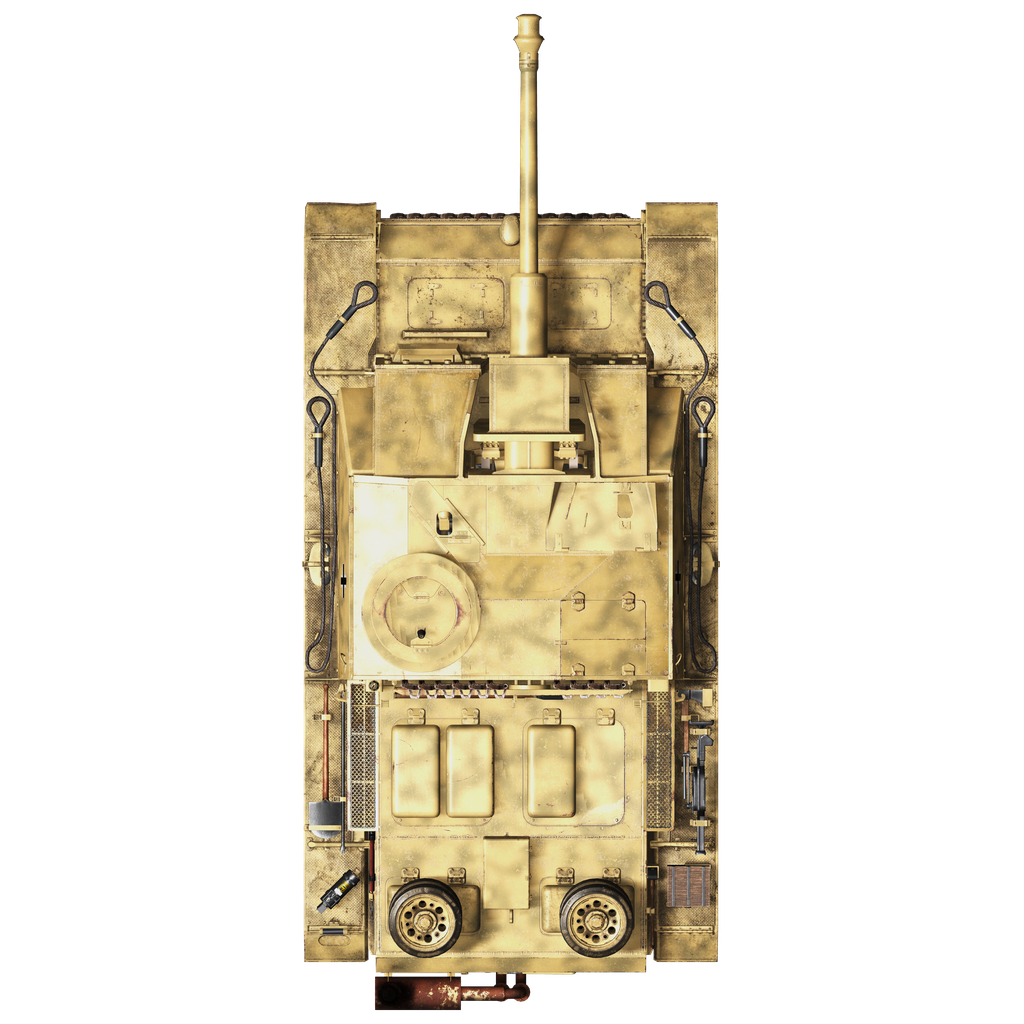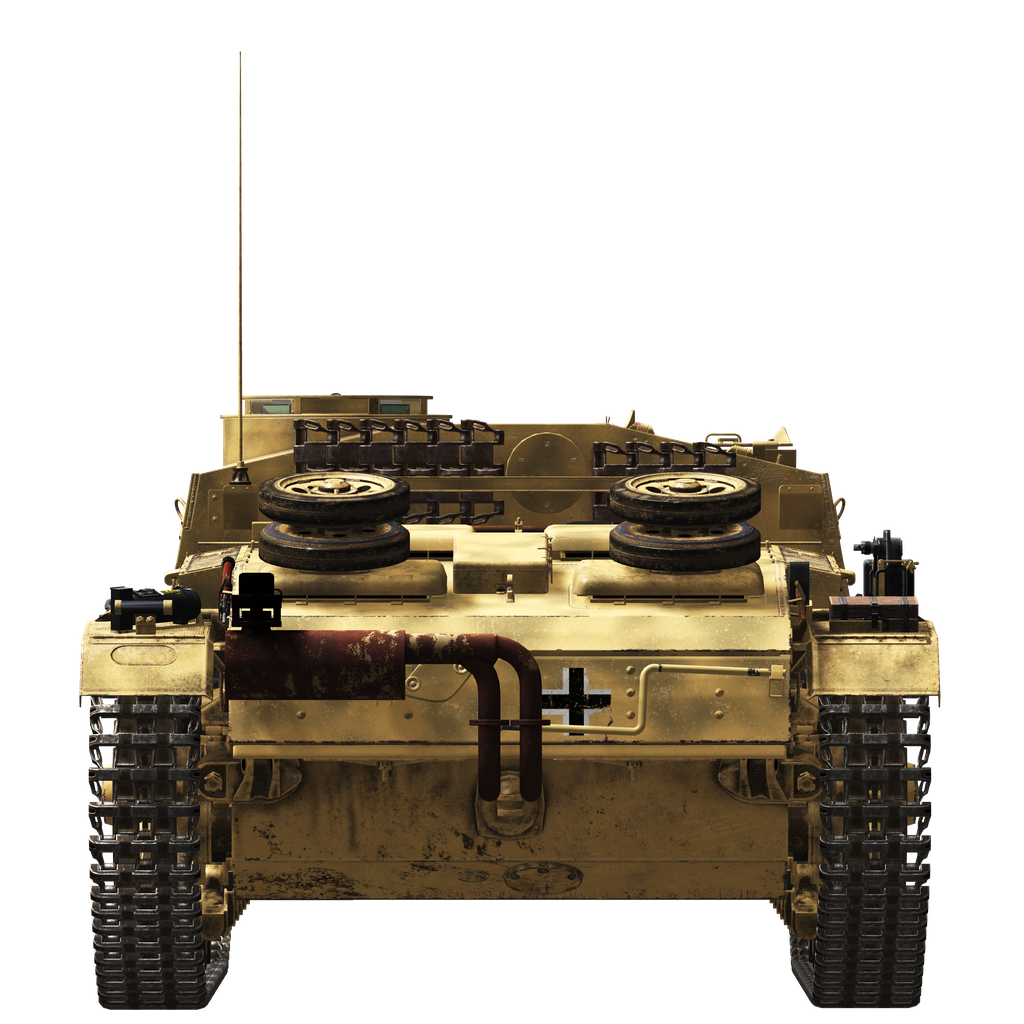Since the Wehrmacht believed that tanks should form the basis of independent formations, the designers at the Daimler-Benz company had been developing a turretless tank since 1936 — a self-propelled assault weapon for infantry support. The combat vehicle they developed in 1940 on the basis of the Pz.III tank received the army designation StuG.III, and in the continuous indexing system of Wehrmacht vehicles — Sd.Kfz.142. The assault gun became the most common armored combat vehicle of the Wehrmacht, and with the reequipment to a long-barreled gun it became the main antitank weapon.
The StuG.III Ausf.G (Sd.Kfz.142/1) had a forward-mounted transmission and casemate. The hull was welded from rolled armor plates and was divided into three compartments: control (also known as transmission), fighting, and engine.
The control compartment was located at the front of the vehicle and contained the driver's seat, control drives, transmissions, and control devices.
In the middle part of the vehicle was the combat compartment with a casemate: here were the seats of the commander, gunner, and loader, weapons and ammunition, sights, and a radio station. The compartment of the G modification had the most refined shape — it was extended to the middle of the fenders and had a commander's cupola.
The engine compartment at the rear of the tank contained the power plant - a Maybach HL120TRM carbureted gasoline engine.
The armament consisted of a 75 mm StuK 40 cannon with a 48-caliber barrel and a rifle-caliber machine gun mounted in a remote-controlled installation on the roof of the casemate, as well as smoke grenade launchers.
The ammunition of the gun consisted of various types of shells: armor-piercing 7.5 cm Pzgr. 39 (6.8 kg, 750 m/s, armor penetration 104 mm at 500 m), sub-caliber 7.5 cm Pzgr. 40 (4.1 kg, 930 m/s, 150 mm at close range), cumulative 7.5 cm Gr.38 HL/S (4.57 kg, 450 m/s, 104 mm) and high-explosive fragmentation 7.5 cm SprGr.34 (5.74 kg, 550 m/s). This modification was equipped with 5 mm armor plates covering the sides of the chassis to improve protection against 14.5 mm antitank rifle rounds.
The Ausf.G became the last and most widespread modification of the assault gun: it was produced from December 1942 until the end of the war. 7834 StuG.III Ausf.Gs were produced without significant changes in design: in November 1943 a new cast iron gun mantle of the type "Saukopfblende" ("pig snout") was introduced, and beginning in 1944 a coaxial MG 34 machine gun was installed. 338 of these vehicles were rebuilt from repaired Pz.III tanks or produced on their chassis.
From 1941 to 1944, assault guns operated as part of separate battalions attached to armies, and in 1944 the formation of assault gun brigades began.
Soviet tank crews found 75mm long-barreled assault guns to be a very dangerous enemy: the low silhouette of the self-propelled guns made it easy to find cover on the battlefield, and the powerful weapons made it possible to knock out tanks from a distance.
Used sources:
1. V. Oswald “Complete catalog of military vehicles and tanks of Germany”, 2002
2. A. Lobanov “Hitler’s Tank Forces” 2010
3. M. Baryatinsky “Assault gun Stug III” magazine “Armor Collection” No. 6 (39) 2001
This self-propelled assault gun Sturmgeschütz III Ausführung G was armed with 75 mm StuK 40 L/48 gun. Ausf.G was one of the last modifications, but the most numerous: 7800 SPG in total since December 1942 till April 1945. Compared to the previous one, it had a longer gun barrel (L/48 instead of L/43) and additional armour sheets installed in the hull and cabin front. The SPG modeled in our sim was built at MIAG factory using the Pz.Kpfw. Ausf.M chassis produced by MAN factory.
The most apparent visual difference was the addition of side armor plates, "Schürzen", which were attached to the hull sides. They were added mainly to protect the tank from massed AT rifle fire which was dangerous for thinner armored sides. Not being able to stop an AP bullet, this additional armour destabilized it or caused its fragmentation before it could hit the main armored hull.
The tank could be equipped with six mortars mounted on the turret and designed to shoot smoke grenades at a distance of about 80 meters.
The long-barrelled 75 mm gun can reliably engage Soviet tanks at distances up to 1 km. However, the artillery periscopic gunsight was less convenient for quick direct firing than telescopic gunsights installed on tanks.
Late StuG III modifications were equipped by infantry MG34 machinegun stored in the fighting compartment. To fire it, the loader had to get out of his hatch, raise the armored shield and set the machinegun up in one of the two positions - for firing at air or ground targets. Six one-shot smoke mortars could be also installed.
| Unladen weight: | 23300 kg |
| Length: | 6.3 m |
| Width: | 3.29 m |
| Height: | 2.2 m |
| Clearance: | 385 mm |
| Engine: | Maybach HL 120TRM, petrol |
| Maximum power: | 300 HP at 3000 RPM |
| Maximum RPM: | 3000 RPM |
| 6 speed gearbox |
| 1-st: | 4.8 kph |
| 2-nd: | 9.2 kph |
| 3-rd: | 15.5 kph |
| 4-th: | 23.5 kph |
| 5-th: | 33.2 kph |
| 6-th: | 42.8 kph |
| Reverse: | 5.9 kph |
| Maximum offroad speed: | 18 kph |
| Internal fuel tanks capacity: | 320 l |
| Engine oil system capacity: | 25 l |
| Summer engine coolant: | 100 l of 40% glysantin |
| Winter engine coolant: | 100 l of 60% glysantin |
| Endurance range: | 155 km |
| Maximum oil consumption: | 2 l/h |
| Gun mantlet: | 50mm rolled armour |
| Cabin front, middle: | 30mm rolled armour |
| Cabin front, lower: | 50мм + 30mm rolled armour |
| Hull front, upper: | 30 mm rolled armour |
| Hull front, middle: | 50 mm rolled armour |
| Hull front, lower: | 50 мм + 30 mm rolled armour |
| Hull front, bottom: | 30 mm rolled armour |
| Cabin rear: | 30 mm rolled armour |
| Hull rear, upper: | 30 mm rolled armour |
| Hull rear, middle: | 50 mm rolled armour |
| Hull rear, lower: | 30 mm rolled armour |
| Cabin roof: | 10 mm rolled armour |
| Cabin rear: | 15 mm rolled armour |
| Sides: | 30 mm rolled armour |
| Bottom: | 15 mm rolled armour |
| 5 mm rolled armor for additional protection against AT rifles |
| Main gun: | rifled, 7,5 cm Stu K 40 L/48 |
| Barrel length: | 55 |
| Elevation: | +17°..-8° |
| Azimuth: | +10°..-10° |
| Ammo: | up to 54 rounds |
| Usable rate of fire: | 10 rounds per minute |
| Turret drive: | mechanical |
| 7.5 cm Pzgr. 39 armor piercing high explosive (APHE): | 6.8 kg, 750 m/s, 104 mm at 500 m |
| 7.5 cm Pzgr. 40 armor piercing composite rigid (APCR): | 4.1 kg, 930 m/s, 150 mm point blank |
| 7.5 cm Gr.38 HL/С high explosive anti-tank (HEAT): | 4.57 kg, 450 m/s, 104 mm |
| 7.5 cm SprGr.34 high explosive (HE): | 5.74 kg, 550 m/s, 660 g. explosives |
(Distance - point number of lower scale):
0000m - 000
0100m - 002 4100m - 110
0200m - 004 4200m - 114
0300m - 005 4300m - 118
0400m - 007 4400m - 123
0500m - 009 4500m - 127
0600m - 011 4600m - 132
0700m - 013 4700m - 137
0800m - 015 4800m - 142
0900m - 017 4900m - 146
1000m - 019 5000m - 151
1100m - 021 5100m - 157
1200m - 023 5200m - 162
1300m - 025 5300m - 167
1400m - 027 5400m - 173
1500m - 029 5500m - 179
1600m - 032 5600m - 185
1700m - 034 5700m - 190
1800m - 036 5800m - 197
1900m - 039 5900m - 203
2000m - 041 6000m - 210
2100m - 044 6100m - 216
2200m - 046 6200m - 223
2300m - 049 6300m - 230
2400m - 052 6400m - 237
2500m - 055 6500m - 244
2600m - 057 6600m - 252
2700m - 060 6700m - 260
2800m - 063 6800m - 268
2900m - 066 6900m - 276
3000m - 069 7000m - 284
3100m - 073 7100m - 293
3200m - 076 7200m - 302
3300m - 079 7300m - 311
3400m - 082 7400m - 320
3500m - 086
3600m - 090
3700m - 094
3800m - 098
3900m - 102
4000m - 106
| Machineguns: | 7.92 mm Maschinengewehr 34 |
| Bullet mass: | 11.5 g |
| Muzzle velocity: | 855 m/s |
| Armour pentration at 100 m: | 11 mm |
| Rate of fire: | 900 rounds per minute |
| 12 magazines, 50 rounds per magazine (600 rounds) |
Gunsights:
Sfl ZF 1a gunner periscopic sight, field of view 8°.
Radio equipment:
VHF Fu 5 transceiver with additional Fu 2 receiver.
4 intercom terminals.
